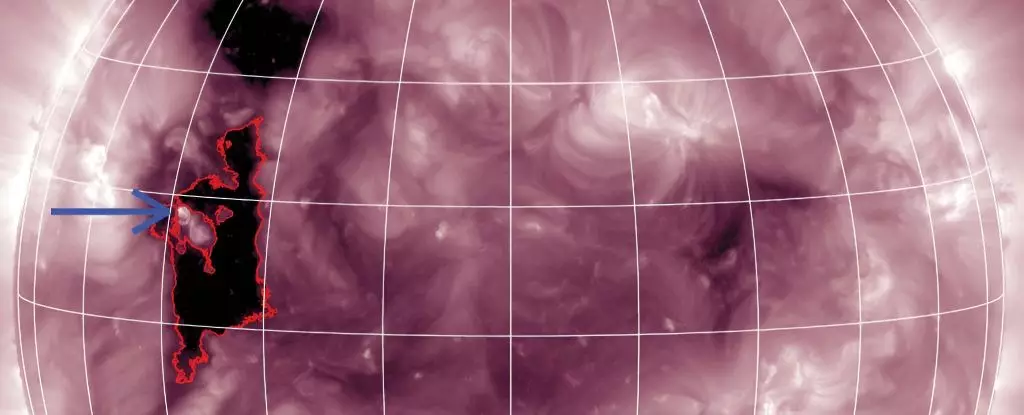In an astonishing development within solar physics, a colossal opening in the Sun’s outer atmosphere has unveiled a rare phenomenon — an unprecedented outpouring of helium-3. Occurring in late October 2023, this episode marked the largest release of this elusive isotope ever detected emanating from our Solar System’s central star. The implications of this astonishing solar eruption resonate far beyond just another astronomical incident; they compel us to rethink our understanding of solar dynamics and the intricate processes that unfold within our Sun’s atmosphere.
The Enigmatic Nature of Helium-3
Helium-3 is a remarkable isotope, distinguished from its more prevalent sibling, helium-4, by a mere single neutron. Its extraordinary rarity is marked by its scarcity in our Solar System, estimated to exist at a proportion of one helium-3 atom per 2,500 helium-4 atoms. Astrophysicist Radoslav Bučík from the Southwest Research Institute highlights this discrepancy, emphasizing that the post-Big Bang conditions contributed to the formation of these isotopes. What’s crucial here is not just the existence of helium-3, but its accelerating behavior as the Sun emits solar jets rich in this rare isotope, potentially due to its unique charge-to-mass ratio. The concentration of helium-3 during the solar event reached dizzying heights, reportedly 180,000 times more than normally observed, leaving scientists in awe and wonder regarding the mechanics behind such a colossal eruption.
Unveiling Coronal Holes and Their Role
The source of this helium-3 surge can be traced to the edge of a coronal hole—a fascinating aspect of solar phenomena that often goes unnoticed. Coronal holes are thin regions in the solar corona characterized by weaker magnetic fields. Although imperceptible in visual wavelengths, these areas present a distinct darkness in ultraviolet and X-ray images, indicating cooler plasma. The weak magnetic fields in coronal holes are crucial for allowing solar winds to escape more readily, propelling charged particles into space at incredibly high velocities. Interestingly, Bučík’s observations suggest that weakening magnetic fields correlate with enhanced helium-3 enrichment, contrary to what might be expected in more vigorously magnetized solar environments.
An Unexpected Chemical Composition
Adding to the intrigue of this solar eruption, the chemical composition of the jet deviated from typical solar particle events. Generally, such events are known to be filled with heavier elements, such as iron or neon. However, the solar jet detected on October 24 and 25 presented a unique profile predominantly composed of lighter elements like carbon, nitrogen, silicon, and sulfur. This unexpected result raises critical questions about the nature of solar particle events — are they truly as rare as this event suggests, or is it more plausible that they regularly occur but often escape detection due to weak intensities? The Solar Orbiter, being strategically stationed halfway between Earth and the Sun, has proven invaluable in providing insights into these celestial phenomena, yet it also leaves us yearning to delve deeper.
Redefining Our Understanding of Solar Events
The implications of this discovery run deep within the broader context of astrophysical research. Traditionally, our interpretation of solar eruptions has been dominated by observations that emphasize the normative activities of our Sun. Yet, this finding introduces a layer of complexity; it encourages a reevaluation of how we perceive the solar atmosphere’s chemistry. The abundance of lighter elements in this unusual solar jet signals that there is much more to discover. This discovery aligns with theoretical considerations indicating that the uniqueness of these jets may often be masked by their relatively weaker presence in standard observations.
The Future of Solar Research
The implications for solar research and our understanding of the solar system dynamics beckon further inquiry. The ability to detect such unique solar events opens a new frontier in our comprehension of stellar behavior, particularly concerning isotopes and their formation dynamics. Moreover, the tantalizing nature of helium-3 presents potential avenues of exploration relating to future energy sources—particularly in nuclear fusion technology. As scientists continue to investigate these phenomena, the Solar Orbiter’s unique positioning will undoubtedly play a pivotal role in uncovering the cosmic secrets tethered to our Sun.
The October 2023 helium-3 surge not only exemplifies the dynamic and often unpredictable nature of solar activity but challenges the scientific community to broaden its horizons and deepen its understanding of our star — a complex entity at the heart of our existence.

